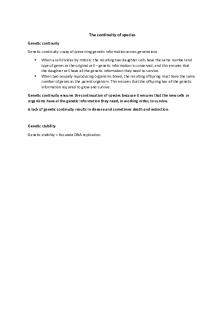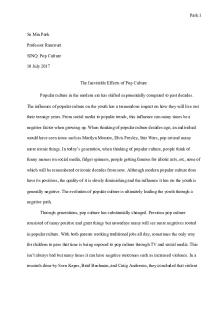Evaluating the effects of epidemics PDF

| Title | Evaluating the effects of epidemics |
|---|---|
| Author | Moses Otieno |
| Course | Healthcare |
| Institution | Kenyatta University |
| Pages | 7 |
| File Size | 137.6 KB |
| File Type | |
| Total Downloads | 76 |
| Total Views | 226 |
Summary
Evaluation Of COVID-Student’s Name Institutional Affiliation Course Instructor’s Name DateEvaluation Of Covid- Consultative engagements between the world health organization(WHO) and other stakeholders have yielded sensitive issues that need to be addressed to improve global healthcare. One striking...
Description
1
Evaluation Of COVID-19
Student’s Name Institutional Affiliation Course Instructor’s Name Date
2 Evaluation Of Covid-19 Consultative engagements between the world health organization(WHO) and other stakeholders have yielded sensitive issues that need to be addressed to improve global healthcare. One striking disparity the WHO seeks to address is in the management of infectious diseases. Minimizing health disparities has been a tremendous public priority in the past decade. Economies like the USA have formidable challenges in addressing the gap in health provision (Ameli,2015). This paper will analyze the disparity in infectious disease management in the USA and Cuba. Though Cuba has a smaller population that offers enables a commendable response to the management of infectious and contagious diseases. Control of COVID 19 provides a framework that many nations admire. Cuba has shown significant skills in the management of infectious and contagious diseases. (Ameli,2015) notes that infectious diseases can cause sixty times more deaths. Proper management is thus advisable in the wake of a pandemic. The united state of America and Cuba have employed significantly different approaches in the management of infectious diseases. Usually, in an outbreak, there are no dependable tools for assessing the performance of surveillance. Proposals are generally made by relevant bodies like WHO, Centre for disease control (CDC). The determinant for success in containing communicable disease thus lies the adoption of swift measures and responsiveness of the health facilities and precautionary measures employed to reduce the spread at the epicenter. Liu et al.,(2020) details the management strategies used in the management of the corona in Wuhan, which included travel restriction in and out o the epicenter, self-quarantine, closure of all public gatherings and employment of ICT in the management of healthcare to reduce the risk of spread. Cuba's health system was able to respond swiftly because of its critical care unit is better equipped.
3
Comparing Health Care Management In The USA And Cuba
Worldwide
COVID -19
4
Health challenge Description
Coronavirus disease infection is gradually rising in the USA and worldwide. Estimating the extent of COVID -19 infection is a challenge because of its quick spread and long incubation period in the human body ( Liu at al,2020). Comparing COVID-19 management in THE united starts and Cuba provides significant challenges because of their different socio-economic economic policies and their demography. Comparison parameters relied upon are the rate of infections, fatalities, and healthcare capacity to contain the virus. Persons who contract COVID 19 are in danger of stigmatization, in addition to other pneumonia-like complications. Emotional risk factor like anxiety snd bullying is also associated with COVID 19, especially in children. Making adjustments regarding lifestyle and dietary habits is an aid in managing this disease. The nutritional habits should include regular aerobic exercises to foster lung activity (Liu et al.,2020)
Country
USA
Cuba
Description of
Adopting multiple policies of
Employed multiple strategies,
policies related
handwashing and regular
including mass testing, restriction
to controlling
sanitization, social distancing
of travel, social distancing, and
COVID-19
lockdowns, and increasing
contact tracing immediately after
infection
healthcare capacity included
the outbreak. (Ritchie et al.,2020).
employing more nurse practitioners and doctors to facilitate testing (Liu et al.,2020).
Strengths of the
The policies addressed the
In addition to standard measures
5 A Plan For Social Change In light of the analysis presented between the USA and Cuban management policies for COVID 19, it's evident that global health issues significantly influence the operations of the local healthcare. Similarly, the activities of nursing practitioners in local healthcare setups are influenced considerably by global health. According to (Liu et al., 2020), the practices adopted by Chinese national healthcare were taken by other countries while preparing to tackle the coronavirus disease. Policies and rules put to in place are often worthless if there is no internal change that supports responsibility. Influence Of Global Perspective In Social Change The changes to the behavior of the society in response to a global emergency constitutes social change. Social change must always be viewed from a worldwide point of view. Stusser (1900-2016) reveals the systemic adjustment that the Cuban government has been putting in response to the global emergencies and benchmark from the experience of other countries. Besides, COVID 19, with its faster global transmissions, has shown that states can not leave indigeneity.makes the inclusion of the worldwide perspective of local nurse leadership role adaptive. Impact Of Global Interdependence Perspective On The Nursing Leadership Role A global perspective is ideal in arming nursing practitioners with vast experience in the wake of epidemics. Being informed about the global occurrences helps the local practitioners make adequate heath adjustment sand, putting working systems in place( Lui et al.,2020). As a local nursing practitioner in a leadership role, proposed international adjustments enable the proper design of public education strategies, ICT adjustments that would improve care, and planning about the protective gear, when considering infectious diseases. (Lui et al.,2020).Also, the world view in the local setup helps sin designing proper behavioral response during a pandemic.
6 Conclusion COVID 19 thrives when the public is reluctant to the demand of living the new normal. A perfect adoption and embrace of WHO guide concerning safety cuts the chains of transmission in the society. The social change focus on dealing with COVID 19 needs to redirect attention to individual responsibility as the government work to manage the new infections. Recognizing the place of social change in healthcare management can significantly impact the control of infectious diseases.
7 References Ameli, J. (2020). Communicable Diseases and Outbreak Control. Communicable Diseases and Outbreak Control. https://www.sciencedirect.com/science/article/pii/S2452247316600596 Dalglish, S. L. (2020). COVID-19 gives the lie to global health expertise. The Lancet, 395(10231), 1189. https://www.thelancet.com/journals/lancet/article/PIIS01406736(20)30739-X/fulltext Liu, W., Yue, X., & Tchounwou, P. B. (2020). Response to the COVID-19 epidemic: The Chinese experience and implications for other countries. International Journal of Environmental Research and Public Health, 17(7), 2304. https://doi.org/10.3390/ijerph17072304 Ritchie, H., Ospina, E. O., Beltekian, D., Mathiew, E., & Hasell, J. H. Stusser, R. J. (n.d.). Cuban and U.S Health Care Systems 1900-2016: Similarities, Differences, and Efficiencies. Cuban and U.S Health Care Systems 1900-2016: Similarities, Differences, and Efficiencies. https://www.researchgate.net/publication/323106292_Cuban_and_US_Health_Ca re_Systems_1900-2016_Similarities_Differences_and_Efficiencies...
Similar Free PDFs

THE EFFECTS OF CORRUPTION
- 5 Pages

Effects of the Sugar REvolution
- 4 Pages

Cholera Epidemics 1870
- 5 Pages

The Negative Effects of Video Games
- 16 Pages
Popular Institutions
- Tinajero National High School - Annex
- Politeknik Caltex Riau
- Yokohama City University
- SGT University
- University of Al-Qadisiyah
- Divine Word College of Vigan
- Techniek College Rotterdam
- Universidade de Santiago
- Universiti Teknologi MARA Cawangan Johor Kampus Pasir Gudang
- Poltekkes Kemenkes Yogyakarta
- Baguio City National High School
- Colegio san marcos
- preparatoria uno
- Centro de Bachillerato Tecnológico Industrial y de Servicios No. 107
- Dalian Maritime University
- Quang Trung Secondary School
- Colegio Tecnológico en Informática
- Corporación Regional de Educación Superior
- Grupo CEDVA
- Dar Al Uloom University
- Centro de Estudios Preuniversitarios de la Universidad Nacional de Ingeniería
- 上智大学
- Aakash International School, Nuna Majara
- San Felipe Neri Catholic School
- Kang Chiao International School - New Taipei City
- Misamis Occidental National High School
- Institución Educativa Escuela Normal Juan Ladrilleros
- Kolehiyo ng Pantukan
- Batanes State College
- Instituto Continental
- Sekolah Menengah Kejuruan Kesehatan Kaltara (Tarakan)
- Colegio de La Inmaculada Concepcion - Cebu











